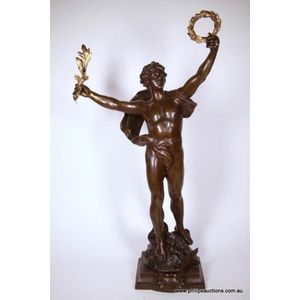Spelter Boy with Mystery Clock
You must be a subscriber, and be logged in to view price and dealer details.
Subscribe Now to view actual auction price for this item
When you subscribe, you have the option of setting the currency in which to display prices to $Au, $US, $NZ or Stg.
- Pendulum - The pendulum was discovered around 1602 by Galileo Galilei, and was adopted for time keeping by the Dutch mathematician and natural philosopher, Christiaan Huygens, who excelled in astronomy, physics, and horology.
The pendulum comprises a metal rod usually of brass or steel with a metal disk, known as a bob, at the end. The movement of the pendulum is driven by weights or a spring, and as a pendulum swings in a regular arc, it was found accuracy could be controlled to within a few seconds a week.
Timekeeping can be adjusted by changing the height of the bob on the rod, making the pendulum either swing slower or faster.
The disadvantage of the pendulum was that changes in temperature also changed the length of the pendulum, interfering with the accuracy of the clock, and so in the 18th century two types of mercurial pendulums were invented which countered the movement in the steel rod.
The pendulum was the world's most accurate timekeeping technology until the invention of the quartz clock, regulated by a quartz crystal, in 1927. - Spelter - Spelter was the name given to an alloy of zinc and brass or copper used in the 19th century for statuary and lighting. It is a brittle bluish-white metal. It was used as a cheap replacement for bronze, but being brittle easily breaks and can't be repaired. When finished it can often be mistaken for bronze, but if discreet a scratch on the base displays shows a greyish colour, the metal is spelter, if a golden colour the metal is most likely bronze.
This item has been included into following indexes:
Visually similar items

An old Indian bronze standing figure of a dancing Shiva, her fine features include headdress, restrained body adornment and well defined facial features, she stands on her right leg with knee bent, raised on a spreading circular double lotus ring base, sli

A spelter male figure of 'Le Triomphe' by Moreau, Louis Auguste (1855-1919), the heroic male figure in a classical stance with billowing girdled drapery, his left hand holding aloft a pair of gilded laurel garlands and in his right, a laurel branch; raised

A Victorian figural spelter mystery clock garniture 'L'amour Vainqueur Par Bruchon', modelled as cupid holding aloft a swinging pendulum clock, with two putto spelter figures 'La Source' and 'La Foret', 57 cm and 25 cm high, (3).

Paul Philippe (French, 1870-1930), Russian dancer, c. 1925 gilt and enamel bronze modelled in a dancing position standing on one foot with the other raised, her arms outstretched, raised on marble plinth base, signed 'P. R. Phillipe'. Height 55 cm
